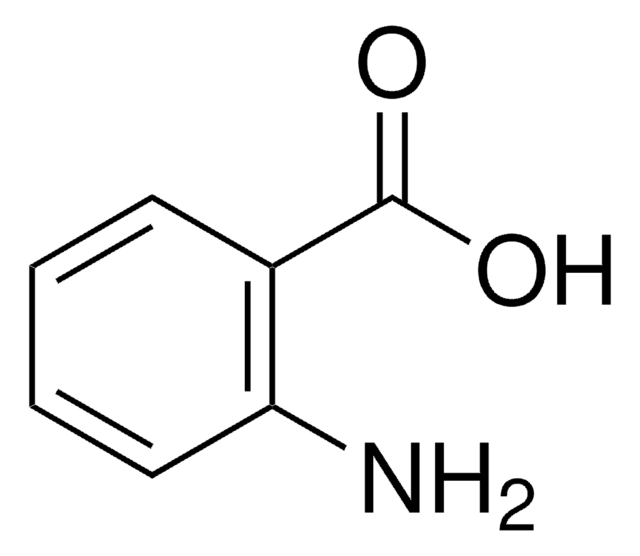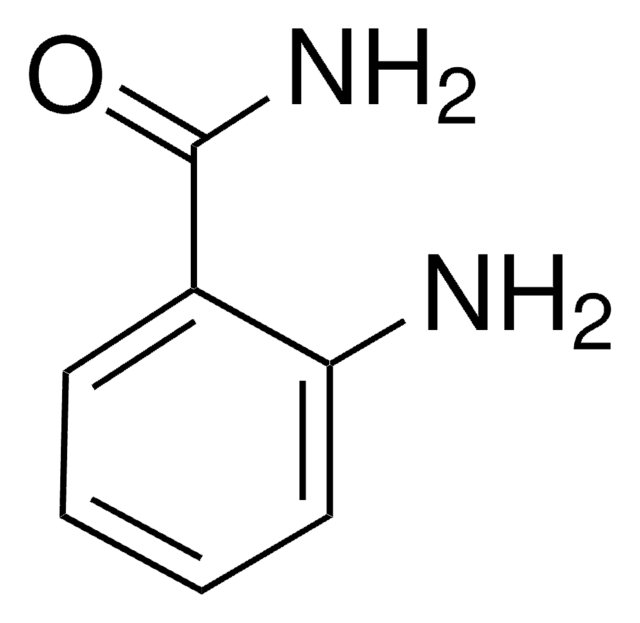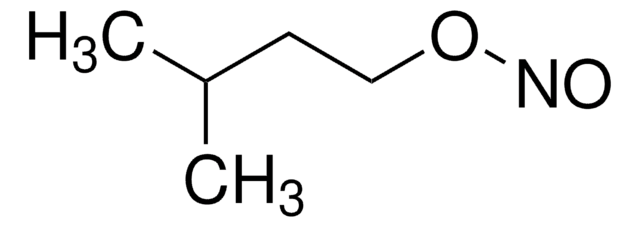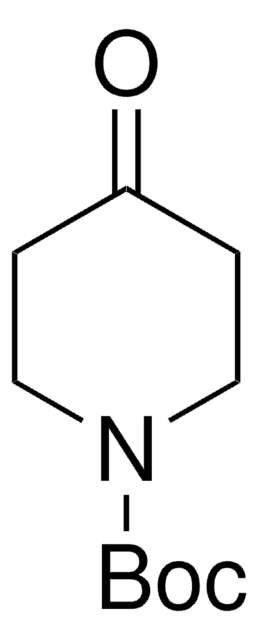A89855
Anthranilic acid
reagent grade, ≥98%
Synonym(s):
2-AA, 2-Aminobenzoic acid
Sign Into View Organizational & Contract Pricing
All Photos(4)
About This Item
Linear Formula:
2-(H2N)C6H4CO2H
CAS Number:
Molecular Weight:
137.14
Beilstein:
471803
EC Number:
MDL number:
UNSPSC Code:
12352100
PubChem Substance ID:
NACRES:
NA.21
Recommended Products
grade
reagent grade
Quality Level
vapor density
4.7 (vs air)
Assay
≥98%
form
powder
mp
144-148 °C (lit.)
functional group
carboxylic acid
SMILES string
Nc1ccccc1C(O)=O
InChI
1S/C7H7NO2/c8-6-4-2-1-3-5(6)7(9)10/h1-4H,8H2,(H,9,10)
InChI key
RWZYAGGXGHYGMB-UHFFFAOYSA-N
Looking for similar products? Visit Product Comparison Guide
Related Categories
General description
Anthranilic acid (2-AA) is an aromatic acid having amino group. It is of medical importance as it plays an important part in generating quinolinic acid in the brain. The crystalline structure of 2-AA has been studied by neutron diffraction. The chemisorption of 2-AA on silver nano-particles have been investigated by Raman and surface-enhanced Raman scattering (SERS) studies.
Application
Anthranilic acid may be used to synthesize 3-imino-2,3-dihydro-4,1-benzoxazepin-5(1H)-one and 9(10H)-acridone.
Used for non-selective, efficient fluorescent labeling of glycans.
related product
Product No.
Description
Pricing
Signal Word
Danger
Hazard Statements
Precautionary Statements
Hazard Classifications
Eye Dam. 1
Storage Class Code
11 - Combustible Solids
WGK
WGK 1
Flash Point(F)
302.0 °F - closed cup
Flash Point(C)
150 °C - closed cup
Personal Protective Equipment
dust mask type N95 (US), Eyeshields, Gloves
Choose from one of the most recent versions:
Already Own This Product?
Find documentation for the products that you have recently purchased in the Document Library.
Interaction of anthranilic acid with silver nanoparticles: A Raman, surface-enhanced Raman scattering and density functional theoretical study.
Chadha R, et al.
Journal of Molecular Structure, 1076, 35-41 (2014)
Generation of 9(10H)-Acridone from Anthranilic Acid.
Ho TL and Jou DG.
J. Chin. Chem. Soc., 48(1), 81-82 (2001)
Cyanomethylation of anthranilic acid.
Mitchell MO and Hurley AR.
Journal of Heterocyclic Chemistry, 40(3), 553-554 (2003)
Anthranilic acid, C7H7NO2, by neutron diffraction.
Brown CJ and Ehrenberg M.
Acta Crystallographica Section C, Crystal Structure Communications, 41(3), 441-443 (1985)
Jun Soma et al.
Nephron, 92(3), 693-698 (2002-10-10)
Tranilast, N-(3,4-dimethoxycinnamoyl) anthranilic acid, suppresses collagen synthesis by various cells, including macrophages and fibroblasts, by interfering with the actions of transforming growth factor-beta 1. We investigated the effect of tranilast on progression of diabetic nephropathy (DN), since this process is
Protocols
Mass Spectrometry of Glycans
Our team of scientists has experience in all areas of research including Life Science, Material Science, Chemical Synthesis, Chromatography, Analytical and many others.
Contact Technical Service









